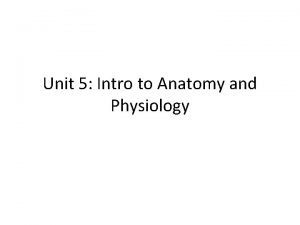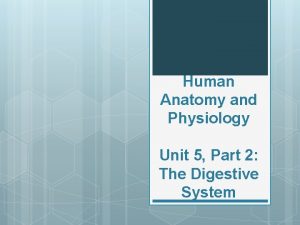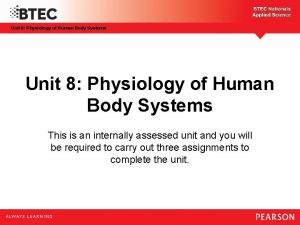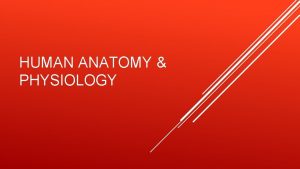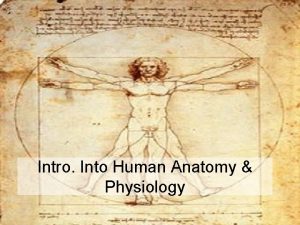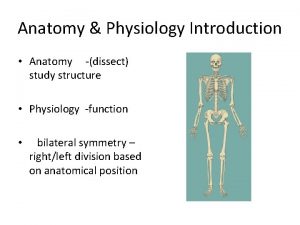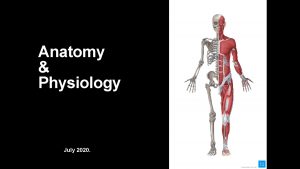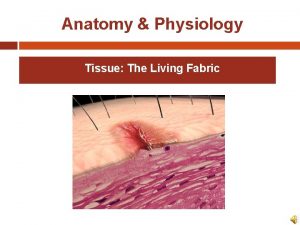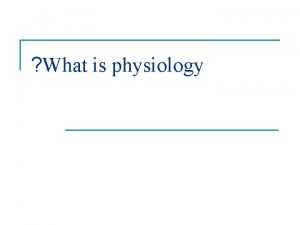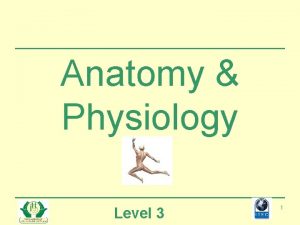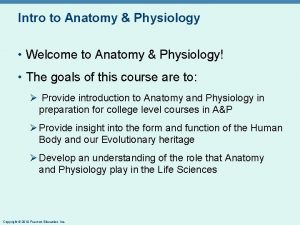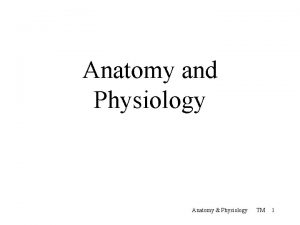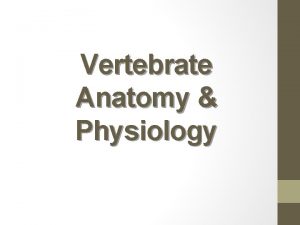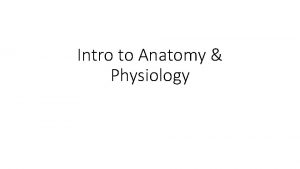Unit 1 Introduction to Anatomy Physiology The Human

























- Slides: 25

Unit 1 Introduction to Anatomy & Physiology

The Human Body – An Introduction • Why did modern medicine begin with observations of the function and malfunction of the human body? • Curiosity about injuries and illnesses • Belief in superstitions and magic notions • What kinds of activities helped promote the development of modern medical science? • Finding useful ways to assist the sick • Observing how the human body heals • Recognizing the effects of injuries • Examining cadavers to determine C. O. D. • Identifying herbs and potions that treat ailments such as coughs, fevers and headaches • Development of new technologies (equipment, synthetic medicine)

The Human Body – A & P • Anatomy – branch of science that deals with the structure (morphology) of body parts – the study of the structure, shape and organization of the body and its parts • Physiology – study of how the body and its parts work or function • Relationship between A & P – Body parts form a well-organized unit—the human organism— each part’s function is dependent on its construction – Ex. hand/grasping; hollow heart chambers/pumping blood; teeth/chewing food • Incisors (cutting teeth); Canines (rip and tear); bicuspids (chewing, grinding, piercing, ripping); molars (chewing, crushing, grinding)

Anatomy – Levels of Study • • • Gross Anatomy • Large structures-brain, heart • Easily observable with unaided eyetongue, skin Microscopic Anatomy Very small structures; Can only be viewed with a microscope, magnifying lens-gastric glands (cells in stomach mucosa) • Cytology = study of cells & organelles • Histology = study of tissues Developmental Anatomy • • • Changes to the body/parts over time Pathological Anatomy • Changes to the body/parts as a result of illness, injury, disease or disorder • Decay, atrophy

Anatomy – Levels of Study • Gross Physiology • • Large body functions • Easily observable activity • Ex. Neurophysiology-how the brain works • Ex. Cardiophysiology-how the heart works Microscopic Physiology • Cellular physiology-cell activity including organelles • Often observed indirectly through measurement • • Developmental Physiology • Change in function associated with structural development • • Ex. Stomach acid Ex. How eyes perceive color Pathological Physiology • Change in function associated with illness, etc. • Ex. Decreased insulin production

Body Landmarks Frontal Cephalic / Optic • Anterior Mental Otic Pectoral Mammary Antebrachial Palmar Genital Pedal

Body Landmarks • Posterior Dorsal(um) Cubital/Olecranal Metacarpal Perineal Plantar Calcaneal

Characteristics of Life • Maintain Boundaries Life processes distinguish living from non-living things. • Skin—pores and keratin • Semi-permeable plasma membrane • Movement • Locomotion • Movement of substances throughout the internal environment and external environment • Responsiveness • Ability to sense changes and react to our surroundings

Characteristics of Life • Growth • Increasing of cell size and number • Construction > Destruction • Reproduction • Production of future generations (offspring) • Respiration • Obtaining O 2, removing CO 2 and releasing energy from foods • Digestion • Break-down into simpler forms that can be absorbed and used

Characteristics of Life • Absorption • Passage of substances through membranes and into body fluids • Circulation • Movement of substances in body fluids • Assimilation / Metabolism • Sum of chemical reactions within the body that break down or build up substances • By the process of cellular respiration, use energy for vital life functions such as formation, growth and repair of body parts. • Excretion / Elimination • Elimination of waste from metabolic reactions

• How are the characteristics of life dependent on metabolism?

Environmental Needs • Water Requirements of organisms in order to survive. • 50– 75% of body weight; most abundant chemical in the body • Required for most metabolic reactions • Transports substances within the body • Assists in regulating body temperature • Food • Provide body with necessary chemicals (nutrients) • Supply chemicals (carbohydrates, proteins, lipids, vitamins, and minerals) to be used as energy sources • Supply raw materials for building new living matter • Regulate vital chemical reactions • Survival depends on the quality and quantity of food available

Survival Needs to Maintain Life • Oxygen • Required to release energy from food substances • Energy acquired drives metabolic reactions • Heat is a form of energy and a by-product of metabolic reactions. • Temperature is a measure of the degree of heat present in the body, which partially determines the rate at which metabolic reactions occur. • Human body temperature must be stable, with a set point of 98. 60 F (370 C)

Survival Needs to Maintain Life • Pressure • Force on the outside of the body due to the weight of air above • Critical for breathing to ensure lungs do not collapse • Heart action produces blood pressure (a form of hydrostatic pressure—force blood places on vascular walls) • Why are both quantity and quality of environmental needs important to survival? • Vital signs are observable body functions that reflect essential metabolic activities to maintain life. • What are vital signs? • Vital signs include: body temperature; blood pressure; pulse (heart rate); respiratory rate; breathing movements

Homeostasis A. Definition = the tendency of an organism to maintain a stable internal environment. Factors in the external environment may change, so if an organism is to survive, what must its internal environment do? B. The body maintains homeostasis through selfregulating control systems. 1) neural vs. hormonal control 2) 3 components of a self-regulating control system: a) receptor b) control center c) effector

Homeostasis • Receptor • Responds to conditions or changes in the internal environment (stimuli) • Sends information to the control center • Control center What is the set-point? • Set-point is the “normal” value (or range) for the condition being maintained • Analyzes information received from the receptor • Compares data to pre-determined set-point • Determines appropriate response and relays that to the effector • Effector • Provides a means for response to the stimulus; alters conditions in the internal environment.

Homeostasis Homeostatic Mechanisms: Negative Feedback vs. Positive Feedback NEGATIVE FEEDBACK HOMEOSTATIC MECHANISM POSITIVE FEEDBACK HOMEOSTATIC MECHANISM

Homeostatic Feedback Mechanisms • Negative feedback Includes homeostatic mechanisms are regulated by negative feedback. 1) Deviation from the set-point is corrected (moves in negative direction) to shut off the original stimulus or reduce its intensity 2) The correction reduces the action of the effectors, preventing the correction from going too far. 3) Works like a household thermostat

Homeostatic Feedback Mechanisms • Positive feedback 1) Increases or amplifies the original stimulus to push the variable farther away from the “normal” state. 2) Because positive feedback mechanisms produce unstable conditions, there are very few of them associated with normal health, have specific functions and do not stay active for very long. 3) Ex. blood clotting; birth of a baby; milk production; orgasm

Homeostasis

Homeostasis AFFERENT PATHWAY EFFERENT PATHWAY

Homeostasis

Homeostasis


 Chapter 1 introduction to human anatomy and physiology
Chapter 1 introduction to human anatomy and physiology Medial lateral distal proximal
Medial lateral distal proximal Endomysium
Endomysium Holes essential of human anatomy and physiology
Holes essential of human anatomy and physiology Chapter 2 human reproductive anatomy and physiology
Chapter 2 human reproductive anatomy and physiology Uterus perimetrium
Uterus perimetrium Anatomy and physiology ninth edition
Anatomy and physiology ninth edition Chapter 1 an introduction to anatomy and physiology
Chapter 1 an introduction to anatomy and physiology Unit 26 self evaluation answers
Unit 26 self evaluation answers Anatomy and physiology unit 7 cardiovascular system
Anatomy and physiology unit 7 cardiovascular system Unit 26 animal anatomy physiology and nutrition
Unit 26 animal anatomy physiology and nutrition Horizontal anatomical plane
Horizontal anatomical plane Esophagus wall
Esophagus wall Unit 8 physiology of human body systems
Unit 8 physiology of human body systems Lower respiratory structures
Lower respiratory structures Tattoo anatomy and physiology
Tattoo anatomy and physiology Anatomy science olympiad
Anatomy science olympiad Incomplete flower
Incomplete flower Bone anatomy and physiology
Bone anatomy and physiology Duodenal ulcer anatomy
Duodenal ulcer anatomy Liver anatomy
Liver anatomy Difference between anatomy and physiology
Difference between anatomy and physiology Hypogastric region
Hypogastric region Straw coloured fluid
Straw coloured fluid The central sulcus divides which two lobes? (figure 14-13)
The central sulcus divides which two lobes? (figure 14-13) Http://anatomy and physiology
Http://anatomy and physiology











